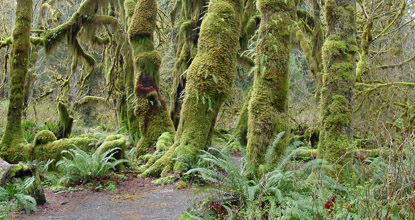
Hoh Rain Forest
I see that people have been coming to this site for advice on removing moss from maple trees. Please don't remove moss from maple trees. That moss supports many animals and it is good for the trees. Lichens are often confused for moss and they can pull nitrogen right out of the air. Nitrogen is a very important nutrient for all plant life including your maple trees. Most plants can not pull nitrogen out of the air and they have to get it second hand from lichens and plant such at Alder Trees. In scientific terms nitrogen is the single largest limiting factor for tree growth in our forests. When you remove that moss and lichen mat you are actually harming your tree!
From The Daily Astorian
"There’s a large amount of biodiversity up there, with 80 different species of moss found on big leaf maple trees alone. Scientists can look at the reproductive biology of plants, how they pollinate and disperse seeds. They can observe the adaptations animals have evolved, like the skin flaps on gliding lizards or flying squirrels.
There are plants in the top branches of trees that create their own communities, living, dying and decaying in tree branches, and creating an arboreal soil high above the ground that becomes home to earthworms, beetles and bugs."
Finally an old growth forest is far more then just big trees; the amount of moss is also one of the factors that determines what is really old growth.
I admit a bias towards mosses because mushrooms and moss go together! Surface moss holds in soil moisture and provides an ideal habitat for mushrooms.
Importance of Mosses, Lichens, and Liverworts to ONP
Coastal areas from Alaska to northern California, including Olympic National Park (ONP), are home to unique forests often referred to as "temperate rain forests". High annual precipitation and mild winter temperatures in these areas result in immense trees and a lush non-vascular flora. The aesthetic experience of visitors to ONP is strongly influenced by the communities of mosses, lichens and liverworts that drape its tree branches and carpet the ground. These organisms, also called 'non-vascular cryptogams' in reference to their simple structure and small size, contribute significantly to the unique character of the park.
Non-vascular cryptogams have important ecological roles in addition to comprising a significant portion of forest biomass. They influence availability of water by intercepting rainfall and fog, reduce the effects of torrential rain, prolong water input after precipitation has stopped, and maintain high humidity which aids growth of other forest vegetation. They provide shelter and nesting materials for animals and birds, and winter forage for deer and small mammals. Non-vascular cryptogams also have a role in nutrient cycling. Most of their nutrients come from the atmosphere and are subsequently added to the rest of the system either through leaching by rainwater or during decomposition after falling from trees as litter. In some systems the nutrient contribution from non-vascular plant litter fall is comparable to that from all vascular plant litter. A significant source of nitrogen in Olympic forest is litter fall of the nitrogen fixing lichen Lobaria oregana.
Lichens, mosses and liverworts also have great potential as indicators for long-term ecological monitoring. They have no protective cuticle so they cannot regulate gain and loss of water. Daily drying and wetting cycles concentrate chemicals and pollutants dissolved in rain, fog, or dust in their tissues. These may include sulfur, nitrogen, metals, radioactivity, and pesticides. Hence, tissues of these organisms have been sampled for decades as indicators of air pollution. If pollution is high enough, the lichens and mosses themselves may disappear. Measurements showing changes in abundance then become important assessment tools for pollution damage. Similarly, some ground dwelling cryptogams are good indicators of soil conditions because they indiscriminately absorb chemicals dissolved in the soil solution.
Consequently, ONP is concerned about the conservation of mosses, lichens and liverworts for many reasons. They are obviously an important aesthetic and functional part of park ecosystems, they are susceptible to changes in air quality, precipitation chemistry and climate, and some species are extremely rare. They are also of management concern because they are illegally harvested from the park in increasing amounts for sale to the floral industry.
1 comment:
In Portland OR on sunny warm days recently, I see clumps of bright green moss and some white clusters have fallen to the sidewalk. Why is this happening?
Post a Comment